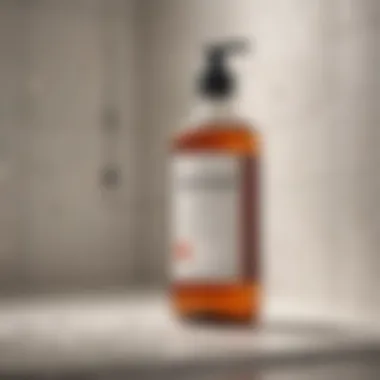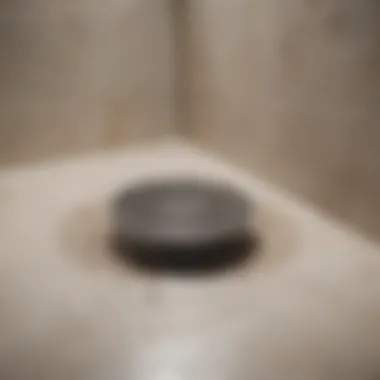Unclogging Your Shower Drain: Baking Soda & Vinegar


Intro
Clogged shower drains are a common annoyance for many homeowners. The accumulated hair, soap scum, and other debris can lead to unpleasant odors and slow drainage. While commercial chemical drain cleaners are available, they often include harsh substances that can damage plumbing and harm the environment. Fortunately, a simple and effective solution exists in the form of two common household items: baking soda and vinegar.
Using baking soda and vinegar offers a natural way to tackle those stubborn clogs. Understanding the science behind their reactions can empower homeowners to maintain their plumbing effectively. This guide focuses on the process of unclogging your shower drain using these ingredients. It will also delve into preventive measures to help avoid future clogs. By the end, you will have a comprehensive understanding of how to apply this method effectively.
Prelude to Shower Clogs
Shower clogs are a common household issue that many homeowners face. Understanding this topic is essential, as it not only affects the functionality of your shower but also can lead to further plumbing problems if not addressed promptly. The significance of knowing how to effectively unclog your shower drain cannot be overstated. This knowledge will save both time and money, preventing the need for expensive plumbing repairs.
Understanding Shower Drain Blockages
To solve a clogged shower drain, it is crucial to understand how blockages occur. Shower drains can become obstructed due to various factors. Hair, soap residue, and other debris can accumulate in the drain over time. This buildup restricts water flow and ultimately leads to a clog. Often, clogs start small and may not be immediately noticeable. However, as the accumulation grows, the water flow becomes severely impacted.
It is also important to note that some blockages may not be visible right away. They can occur deep within the plumbing system. Even if the drain appears to be draining slowly, it can indicate a larger problem brewing deeper in the pipes.
Common Causes of Clogs
There are specific common culprits that contribute to shower drain clogs:
- Hair: This is the most prevalent cause. Loose strands can easily latch onto soap scum and form larger clumps.
- Soap Residue: Many soaps leave behind a film that can combine with hair, creating a sticky barrier that traps other debris.
- Skin Flakes and Other Particles: Tiny bits of skin and particles from various products also play a role.
- Foreign Objects: Small objects accidentally dropped, like shampoo caps or toys, can lead to sudden clogs.
Identifying and tackling these causes early is critical to maintaining a clear shower drain.
Understanding these factors will empower you to proactively manage your shower drain effectively. This knowledge also sets the stage for exploring cleaning solutions, such as the natural methods involving baking soda and vinegar, detailed further in this guide.
Chemical Properties of Baking Soda and Vinegar
Baking soda and vinegar is a popular combination for managing household clogs, including those hard-to-reach blockages found in shower drains. Understanding the chemical properties of these two ingredients is crucial. Not only does it reveal their cleaning potential, but it also emphasizes the significance of choosing natural remedies over harsher chemicals.
The Science Behind Baking Soda
Baking soda, or sodium bicarbonate, is a white crystalline powder commonly used in baking and cleaning. When dissolved in water, it produces a mildly alkaline solution. This alkaline quality makes it effective in breaking down grease and organic materials, which are often the culprits behind drain clogs. Using this product as a cleaning agent leverages its ability to neutralize odors as well. In addition, it is non-toxic, making it safe for both humans and the environment.
The effectiveness of baking soda can be further explained through its ability to react with acids. This feature is vital for its role in unclogging drains. When it encounters acidic compounds, it undergoes a reaction that produces carbon dioxide gas. This gas helps agitate and loosen debris within the pipes, allowing for easier removal.
The Role of Vinegar in Cleaning
Vinegar, particularly white vinegar, is a liquid composed mainly of acetic acid and water. Its acidity gives it powerful cleaning properties. It is effective at breaking down mineral deposits, soap scum, and other residue in shower drains. This acidic nature allows vinegar to dissolve buildup that might cause blockages, making it an ideal partner for baking soda.
Additionally, vinegar also has natural antibacterial properties. This means that not only does it remove clogs, but it also sanitizes the surfaces it cleans. The use of vinegar ensures that the shower drain is free from germs and unpleasant odors. Its versatility extends beyond drain cleaning, as it can be used in a variety of household cleaning tasks.
How They Interact
When baking soda and vinegar are combined, they do more than just merge their individual properties. The acid-base reaction between vinegar's acetic acid and the alkaline baking soda creates carbon dioxide bubbles, which effectively lift away debris from the drain walls and dislodge buildup.
- Initial Reaction: The moment these two ingredients come together, a fizzing action occurs. This bubbling helps to penetrate and disrupt any clogs.
- Penetrating Debris: The resulting carbon dioxide bubbles can access and agitate material that might be stuck in less visible areas of the drain.
- Thorough Cleaning: Once the reaction subsides, the hot water used afterward helps flush away the debris, leaving your drain cleaner.
This dynamic duo offers a natural, effective, and safe solution for maintaining clean drains. The combination of baking soda’s grime-fighting capabilities coupled with vinegar’s ability to dissolve unwanted residue creates a powerful force in keeping shower drains unclogged.
Preparation for Drain Cleaning


Preparing for drain cleaning is a critical step that can significantly influence the overall success of the unclogging process. Whether you are using simple household items like baking soda and vinegar, or other methods, taking the time to prepare can save you effort, time, and potential damage. Proper preparation not only enhances the effectiveness of the cleaning method you choose but also ensures you have all necessary materials at your disposal, allowing for a streamlined approach. Furthermore, understanding safety protocols will protect you and your plumbing system during the process.
Gather Necessary Materials
To start, you will need to gather a few essential items before attempting to unclog your shower drain. Having everything within reach prevents interruptions and allows you to focus on the task at hand. The primary materials include:
- Baking Soda – A key ingredient known for its ability to absorb odors and break down grime.
- White Vinegar – The acidic component that interacts with baking soda to dissolve clogs.
- Boiling Water – Helps to flush away debris following the application.
- Measuring Cup – For accurate measurements, if needed.
- Cloth or Towel – To keep the area tidy and to catch any spills.
- Plunger – In some cases, a plunger may assist with breaking up stubborn clogs.
Before you commence, ensure your shower is dry and clear of any items that might obstruct your work. A clean workspace maintains focus and minimizes mess.
Safety Precautions
When dealing with any cleaning process, especially those involving chemical reactions, safety should be a top priority. Even when using household items, it is crucial to follow certain precautions to ensure a safe experience:
- Wear Gloves �– Protect your hands from substances, especially if you have sensitive skin or existing conditions.
- Ensure Ventilation – Open windows or turn on fans to facilitate good air flow, particularly if there is a strong odor.
- Avoid Mixing with Other Chemicals – Never combine vinegar and baking soda with commercial cleaners as this can lead to harmful reactions.
- Protect Your Eyes – Use goggles if you have sensitive eyes or if there is a risk of splashing.
Taking these simple steps can prevent accidents and ensure that although the process can be effective and natural, safety remains paramount.
"Preparation is the key to success. Having your tools and materials ready enhances effectiveness and reduces risk."
By acknowledging the importance of preparation and adhering to safety protocols, you can approach the task of unclogging your shower drain with confidence. This deliberate focus on readiness sets a strong foundation for achieving a clean and efficient drain.
Step-by-Step Guide to Unclogging
Understanding how to effectively unclog your shower drain is essential for every homeowner. A clogged drain is not just an inconvenience; it can lead to further plumbing issues if not addressed promptly. Using a systematic approach ensures that each step of the unclogging process is executed correctly. This guide provides a comprehensive roadmap to tackle clogs using baking soda and vinegar, which are both safe and readily available household items. By following this step-by-step guide, readers can efficiently restore their shower drains to optimal performance.
Initial Assessment of the Clog
Before diving into the cleaning process, assessing the severity and cause of the clog is crucial. Begin by observing how the water drains. If it is draining slowly or not at all, it indicates a blockage. You should check for visible signs of hair, soap residue, or any other debris. Sometimes, a simple inspection can reveal heavy accumulation near the drain cover. Taking note of these indicators can help determine the extent of the clog. Ensuring the area is dry and accessible can set the stage for effective cleaning.
Inserting Baking Soda
Once assessment is complete, the first action to take is inserting baking soda into the drain. Pour approximately one cup of baking soda down the drain directly. This ingredient is a natural abrasive, which means it can help dislodge some accumulation in the pipes. If there is a large buildup, you might consider using a smaller tool like a funnel to guide the baking soda more precisely into the drain. The key here is to ensure it reaches as far into the drain as possible, enhancing its efficacy. The absence of water will allow the baking soda to sit and work on the clog more effectively.
Adding Vinegar
After allowing the baking soda to settle momentarily, it is time to add vinegar. Use about one cup of white vinegar and pour it down the drain over the baking soda. The interaction between the baking soda and vinegar generates carbon dioxide gas and other compounds that help break apart the debris clogging your drain. This reaction can produce fizzing sounds, which are signs that the process is working effectively. Let this combination sit for at least 15 to 20 minutes without interruption.
Allowing the Mixture to Work
Patience is essential now as the mixture of baking soda and vinegar continues to react. This period is critical, as it allows the solution to penetrate the blockage fully. During this time, it can disintegrate accumulated soap scum, hair, and other organic matter. Refrain from running water during this process to maintain the pressure and effectiveness of the mixture. If it seems to be taking too long or the clog persists, you may wish to repeat the baking soda and vinegar step for a more potent effect.
Flushing with Hot Water
Once the reaction time has passed, it is imperative to flush out the drain with hot water. Boil a kettle of water and carefully pour it down the drain. The hot water will help wash away the loosened debris and clear any remaining residues. This final step removes any lingering traces of the clog and ensures that your drain runs freely. If the water does not drain as expected after this step, additional interventions may be necessary.
Tip: For best results, repeat the entire process regularly to maintain optimal drain function. This will help prevent future clogs before they develop.
By following these steps diligently, homeowners can effectively utilize household products like baking soda and vinegar to tackle common shower drain clogs. This method not only saves money on store-bought cleaners but also reduces the necessity for harsh chemicals that may harm the environment.
Post-Cleaning Maintenance


Post-cleaning maintenance is a critical aspect of ensuring long-term functionality for your shower drain. After utilizing baking soda and vinegar to clear blockages, the next steps focus on preserving that clean state. A proactive approach to maintenance reduces the chance of future issues and promotes a hygienic environment in your bathroom.
Inspecting the Shower Drain
Regularly inspecting your shower drain is essential for maintaining its health. This process involves visual checks and a clear understanding of signs indicating potential problems. Here are some key points to consider:
- Visual Inspection: Look for standing water, which might signal partial clogs. If water doesn’t drain away quickly after usage, it could indicate buildup.
- Odor Check: Unpleasant smells can indicate stagnant water or mold. Such signs suggest that more than just hair or soap scum needs addressing.
- Physical Debris: Inspect for any visible foreign substances. Hair, soap, and mineral deposits gather over time, leading to clogs.
Taking these measures periodically can help catch problems early, rather than waiting for a malfunction.
Regular Maintenance Schedule
Establishing a regular maintenance schedule can save time and resources by preventing serious clogs from developing. Here are practical steps you can implement:
- Monthly Cleaning: Dedicate time every month to perform a basic cleaning. Pouring a mix of baking soda and vinegar down the drain can help keep any buildup in check.
- Seasonal Deep Cleaning: Every few months, consider doing a more thorough cleaning. This might include removing the drain cover to directly clean out debris.
- Monitor Usage: Note how often the shower is used, especially in larger households. Increased usage means more frequent maintenance might be required.
By committing to a cleaning schedule, you can foster a better atmosphere in your bathroom, ensuring that minor clogs are dealt with before they escalate into more serious issues. Routine checks and a dedicated maintenance plan are integral parts of keeping your shower drain unclogged and functional.
Preventing Future Clogs
Preventing future clogs is essential for maintaining a smoothly functioning shower drain. It saves you time, effort, and money that might otherwise be spent on repairs or professional cleaning services. The key is to implement practical strategies that can significantly reduce the likelihood of blockages occurring.
Promoting Good Drain Hygiene
Maintaining proper drain hygiene is crucial in preventing clogs. This involves being conscious of what goes down the drain and regularly cleaning the area. Here are some useful tips:
- Rinse Off Soap and Hair: After each shower, let the water run for a minute to help wash away soap scum and hair remnants. This simple act can prevent buildups that lead to clogs.
- Use Shower Mats: Consider placing a mat outside the shower to capture loose hair and debris. Wash these regularly to ensure they do not become a source of odor or bacteria.
- Regular Cleaning: Schedule monthly cleanings. Use a mixture of hot water and a small amount of dish soap to flush the drain. This will help to remove soap buildup and other debris before they solidify into a clog.
By promoting good drain hygiene, you minimize the risk of future clogs and keep your shower drain functioning well.
Utilizing Drain Covers
Drain covers are an often overlooked but effective tool in preventing clogs. These simple devices can trap hair and larger particles that could cause blockages.
- Choose the Right Cover: Select a drain cover that fits snugly over the drain and has holes small enough to catch hair while allowing water to flow freely.
- Regular Maintenance: Clean the drain cover regularly to ensure it remains effective. Hair and soap can accumulate quickly, so routine cleaning helps prevent clogs from forming.
- Cost-Effective Solution: Drain covers are inexpensive and easy to install. Investing in one can provide long-term benefits by minimizing the frequency of clogs.
By utilizing drain covers, you take an active role in preventing clogs, enhancing the longevity and efficiency of your shower drain.
"Regular maintenance and prevention strategies are key to ensuring your plumbing system functions without issue."
Alternative Methods for Clog Removal
When dealing with shower clogs, many individuals may find themselves seeking alternatives to the traditional methods of unclogging drains. This section delves into two notable alternatives: the use of salt combined with baking soda, and the option of commercial drain cleaners. Understanding these methods is essential for homeowners seeking effective solutions that fit their cleaning preferences and environmental considerations.
Using Salt and Baking Soda
Salt mixed with baking soda is a surprisingly effective alternative for unclogging shower drains. Salt acts as a natural abrasive, enhancing the cleaning power of baking soda. The combination works to dislodge debris and grease from the drain.
Benefits:
- Natural Ingredients: Unlike chemical cleaners, the mixture is biodegradable and poses less risk to plumbing.
- Cost-Effective: These are common household items that most people already have in their kitchens.
- Easy Application: The method does not require sophisticated tools or lengthy preparations.


To use this technique, simply mix equal parts of salt and baking soda, and pour it down the drain. Follow this with hot water to flush out any loosened debris. This method is particularly effective when used regularly as a preventive measure against clogs.
Commercial Drain Cleaners
Commercial drain cleaners are another alternative for dealing with stubborn clogs. These products are specifically designed to break down waste and clear blockages in drains. They often contain powerful chemicals that can provide quick results.
Considerations:
- Efficiency: Many of these products can work very quickly, often within mere minutes.
- Availability: They are widely available in supermarkets and hardware stores, making them easy to obtain.
- Potential Risks: There are some drawbacks. These cleaners can be harsh on plumbing if used excessively. They may also have negative environmental impacts due to the chemicals involved.
When choosing a commercial drain cleaner, it is vital to read the label and understand the potential risks. If you decide to go this route, ensure proper ventilation and follow safety precautions during usage.
"Always consider the long-term effects of any product you use on your plumbing and the environment."
Environmental Considerations
Understanding the environmental considerations surrounding the use of chemical drain cleaners is critical. It plays a significant role in promoting sustainable habits in home maintenance. As homeowners become more aware of their ecological footprint, opting for methods that minimize environmental harm reflects a growing consciousness about our planet. The following sections will delve into the impact of chemical drain cleaners and highlight the benefits of natural alternatives like baking soda and vinegar.
Impact of Chemical Drain Cleaners
Chemical drain cleaners have become common solutions for unclogging drains. These products often contain harsh ingredients meant to dissolve blockages quickly. However, their impact goes beyond simple clog removal. Many chemical cleaners release toxic fumes that can be harmful when inhaled. Prolonged exposure may lead to respiratory problems or skin irritations. When these chemicals wash down the drain, they often end up in our waterways.
"Many standard drain cleaners can contain substances that lead to environmental degradation and health risks."
Additionally, chemical drain cleaners can disrupt the natural balance of microbial life in wastewater treatment facilities. This disruption can lead to inefficiencies in treating sewage, ultimately resulting in untreated sewage entering water bodies. This contamination can harm aquatic life and deteriorate water quality. While these cleaners might seem effective in the short term, their long-term environmental consequences raise significant concerns.
Benefits of Natural Alternatives
Shifting focus to natural alternatives presents many advantages. Using natural substances like baking soda and vinegar is an environmentally friendly approach to drain cleaning. These items are biodegradable, posing no harm to ecosystems when disposed of.
Moreover, these natural alternatives do not release harmful chemicals into the air or water. This means a safer atmosphere during application and minimized risks to health. With a chemical-free approach, households contribute to healthier indoor air quality and protect the local environment.
Natural alternatives also tend to be cost-effective. Purchasing baking soda and vinegar is generally less expensive than commercial drain cleaners. These common household items can be easily integrated into regular cleaning routines without special handling or packaging concerns.
Culmination
In this guide, we explored the effective method of using baking soda and vinegar for unclogging shower drains. Understanding this process is vital for homeowners who prefer natural cleaning solutions over harsh chemicals. The overall benefits include protecting the environment, reducing the risk of damaging plumbing, and saving money on commercial drain cleaners. This guide instills confidence in readers, showing them that a simple combination of household items can resolve a pesky issue.
Recap of the Process
To recap, the unclogging process involves several key steps:
- Initial Assessment of the Clog: Identify the type and severity of the blockage before proceeding.
- Inserting Baking Soda: Pour the baking soda directly into the drain, which helps to break down residues.
- Adding Vinegar: Next, add vinegar to generate a fizzing reaction, aiding in dislodging the clog.
- Allowing the Mixture to Work: Let the mixture sit for about 20-30 minutes to maximize its effects.
- Flushing with Hot Water: Finally, flush the drain with hot water to clear any remaining debris.
Each of these steps contributes to a thorough unclogging process that is both effective and safe for your plumbing.
Final Thoughts on Clog Prevention
Preventing future clogs is essential for maintaining a properly functioning shower drain. Here are a few strategies to consider:
- Promoting Good Drain Hygiene: Encourage family members to avoid allowing excessive hair and soap waste down the drain.
- Utilizing Drain Covers: Consider adding drain covers to catch hair and debris before it enters the plumbing system.
By implementing these practices, you help ensure that your shower remains free from blockages.
"An ounce of prevention is worth a pound of cure."
Over time, consistent attention to drain maintenance can save you from the hassle and expense of dealing with severe clogs.















